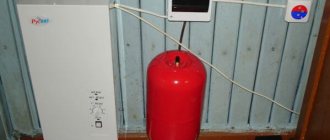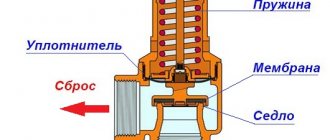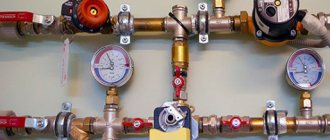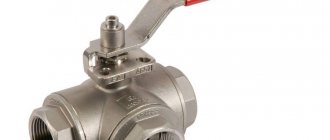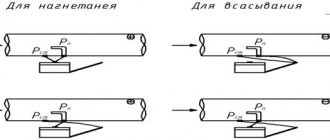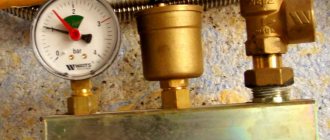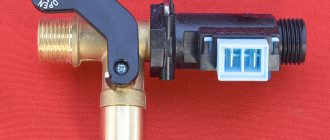Other causes of high blood pressure
An increase in pressure in the heating system is also possible due to the fact that:
- The shut-off valve is partially or completely blocked. As a result, the water supply pressure increases sharply and the boiler is blocked. It is necessary to open shut-off taps and valves, check the heating fittings for leaks;
- If a mechanical mud filter is installed, its mesh may become clogged with particles of rust, slag or sand. As a result, pressure rises in the boiler-filter section. Washing the filters will help relieve the coolant pressure. The simplest corner filter needs to be washed at least 3-4 times a year. Wash and magnetic filters are more expensive, but such devices purify water better and require cleaning only once a year;
- The make-up water tap is leaking or not “holding”. The pressure in the water supply network is in the range of 2.5 - 3.5 bar, that is, water will flow into the heating system, where the pressure is lower. This will inevitably lead to an increase in the volume of coolant. To solve the problems, you need to turn off or replace the make-up water valve. Most often, rubber gaskets become unusable and require replacement. As a temporary solution to the problem until the damaged parts are replaced, you can reset the indicators by completely shutting off the water supply to the double-circuit boiler;
- Malfunction of the boiler automation, failure of the thermostat or controllers. It is not always possible to determine why this happens. The reason may be manufacturing defects, the use of low-quality materials in the manufacture of the control board, incorrect installation, etc. You can fix the problem yourself if you know the error code and have the technical data sheet of the device. If the technical data sheet does not contain an error code and a method for eliminating it, you cannot do without a service department.
Reasons for the increase in pressure in a gas boiler
In addition to the pressure gauge readings, frequent discharge of water through the safety valve and blocking the operation of the device help to detect an increase in pressure in a gas boiler. Having determined high pressure, first of all, excess air is released through the Mayevsky taps and the boiler is turned off. There may be several reasons for malfunctions.
The normal upper pressure value is ensured by the system by discharging excess coolant through a safety valve into the drain
An increase in pressure in a gas boiler can be caused by damage to the partition of the secondary heat exchanger, which simultaneously serves to insulate and increase the contact area of two circuits - heating and hot water supply.
The secondary heat exchanger takes water from the heating circuit for preparing and supplying hot water in a double-circuit boiler. Damage to the partition leads to the forcing of water from the hot water circuit into the heating system, increasing the pressure in it.
The secondary heat exchanger serves to service the hot water supply system. Water for domestic hot water is heated as a result of contact with the coolant of the heating circuit. The system is protected from mixing the two circuits by a metal partition, damage to which leads to the exchange of liquids and disruption of normal pressure
Replacing the heat exchanger will solve the problem. You can carry out repairs yourself, but it is not advisable to do this, since interfering with the operation of gas equipment requires knowledge and experience in this area. In addition, repairing the boiler yourself will deprive you of the right to warranty service.
A malfunction of the automatic gas boiler or a loose pump impeller, which sucks in air, also increases the pressure in the gas boiler. Equipment malfunctions that lead to disturbances in normal pressure may be the result of a manufacturing defect, a breakdown of the control board, or an incorrectly configured system. Only a qualified technician can fix this kind of problem.
Why did the water pressure drop?
What affects the indicators in the circuit:
- The installation height of the housing, as a result - the height and length of the pipes.
- The effect of liquid on pipes and other elements.
- Construction of main tracks.
If your home has autonomous heating, then the standards depend on:
- Boiler models, pipeline paths.
- Installation locations.
- Number of floors in the building.
- Characteristics of the outer pipe.
Next we'll look at non-installation related reasons. If the device releases and does not gain pressure, this may be an internal failure or external factors.
Leak in the system
You add coolant to the circuit, but the pressure is still low. If the batteries heat up well, the moisture evaporates quickly, making the leak difficult to detect. Take a dry cloth and go over all pipe joints and connections. Look, there may be puddles accumulating under the radiators.
If the leak cannot be detected, use a compressor.
- Disconnect the radiators from the heating device.
- Drain off all liquid.
- Connect a compressor to the taps.
- Bleed the circuit with air.
- You will hear extraneous sounds in places where there is damage.
- To seal, use plumber's tow or sealant.
Incorrectly selected boiler - the power does not correspond to the established parameters of the pipeline. Therefore, the pressure constantly drops and does not hold.
If the values drop quickly, the cause may be the expansion tank. At the same time, you fill in the coolant every week, but it is becoming less and less, although no leaks have been detected. There is also a pressure drop in the mixers.
How to gain and improve performance:
- Turn off the water supply valves.
- Drain the circuit completely.
- Open the fitting on the expansion tank (RB) and record the numbers.
- Pump air until all the water comes out.
- Bleed the air and repeat the steps. Make sure that the needle on the pressure gauge does not exceed 1.3 bar.
- Open the taps and fill in the liquid.
If after the procedure the pressure drops and does not rise, inspect the membrane for damage. Replace if necessary.
Heat exchanger malfunction. After checking the pipes and connections, were there any violations found? Inspect the radiator for damage. A large accumulation of scale on the tubes leads to frequent flushing with reagents. This causes the material to quickly wear out and cracks to appear.
The bithermic unit cannot be repaired due to its design. Will need replacement. If a tubular radiator is installed, remove it. Fistulas can be detected by green spots on the surface. Dry the device and clean the damaged area with sandpaper. Then carry out soldering with a soldering iron or torch.
Problems with the water supply valve. When a faucet leaks, it leads to a constant drop in pressure. How to add coolant to the system? Only replacing the part will help.
Problems with the three-way valve. In dual-circuit devices, the valve serves to switch flows from heating to hot water supply. Clean the valve; scale and debris may interfere with its operation.
Airiness. It is not difficult to determine that there is an air pocket in the batteries. This is clear from the gurgling sounds where water collides with air. Do this:
- Record the pressure gauge values.
- Turn off the equipment.
- Place the container under the Mayevsky tap and open its valve.
- You will hear air moving and liquid may drip. Wait until the hissing stops.
- Turn on the water and supply it until the pressure gauge needle reaches the starting position. Turn off the taps.
- Start the boiler and listen to the operation. If sounds are heard again, repeat the procedure.
Problems with gas in the main
Interruptions in the fuel supply lead to heating problems and blocking of the boiler. For what reasons do interruptions occur:
- Clogged gas fittings: filters, nozzles, hoses.
- Gas supply valve is faulty or clogged.
- Fuel leak. Close the valves and call the gas service.
As you can see, problems with the operation of the boiler arise for both internal and external reasons. If you are unable to locate the problem, call a technician. He will diagnose the system and fix the problem.
A frequent cause of malfunctions in the operation of a gas boiler is a rapid decrease in pressure in the heating system. This often results in the device turning off. Then the owners have a question about how to add pressure to the gas boiler. The answer to this depends on the reason for the decrease in the indicator on the pressure gauge.
Gas boiler pressure control
All modern heating equipment is equipped with control sensors. A pressure sensor monitors normal operation. In case of deviation from the norm, it sends a signal to the control module, causing the boiler to be blocked. Additionally, an error code may appear on the display.
What pressure should it be? A pressure gauge helps you track the values. The mounted Bosch, Ariston, Navien, Baxi unit installed in the house maintains values from 1.5 to 2 atm. A drop in performance is observed only in systems with forced fluid movement (pump).
How the equipment works
Under normal conditions, work proceeds like this:
- Sensors record the coolant temperature. If an external thermostat is installed, the burner automatically lights and heats up.
- As the temperature rises, the pressure rises. When heated, water expands, so an expansion tank is provided to discharge excess coolant. The safety valve also discharges excess into the drain.
- If there is a malfunction, too much water is drained. As a result, the pressure drops.
- As soon as the temperature reaches the set temperature, the boiler turns off.
More details about the operation of the expansion tank:
- The tank consists of two parts, which are divided by a diaphragm. In one cavity there is nitrogen, in the other excess liquid accumulates.
- The coolant fills it as much as the difference in the values of the system and nitrogen.
- As soon as the heating stops, nitrogen pushes water out of the cavity by deforming the membrane.
Why does the pressure in a gas boiler decrease?
For the heating system to work correctly, it is necessary that the pressure in it is maintained at a level of 0.7-2.5 atm. But in different models of units, the indicators may change; they are indicated in the technical characteristics of a particular device. A significant decrease in pressure indicates problems in the heating system. In modern gas boilers, the diagnostic system notifies of a problem using an error code displayed on the screen.
If the pressure gauge shows pressure below 1 atm, you need to add coolant to the system. For this purpose, modern gas boilers have a make-up tap. It can be manual or automatic, the latter from time to time adds liquid to the system without the participation of the owner. This type of crane is installed on expensive premium units. Most boilers are equipped with a conventional manual element.
If, after adding fluid to the system, the pressure drops again, you should look for the source of the problem.
There are many reasons for a decrease in pressure in a gas boiler. It is important to quickly find it and eliminate it. Let's look at the common causes of low pressure in the heating system.
Presence of air pockets
The presence of air accumulations is detected due to the occurrence of noise and vibration in places where they are concentrated. As a result, the radiators warm up poorly, since the air does not transmit heat well.
This problem forces the unit to wear out, which causes gas consumption to increase significantly.
Solving the problem of air jams is quite easy - you should open the nearest Mayevsky tap and release excess oxygen.
Leak in the heating system
One of the most common reasons for a decrease in pressure is a coolant leak. Even when adding fluid to the system, after a short time the pressure drops again. You need to find the location of the leak; first, it is better to examine the joint areas, since weak spots often appear on them. You can take a dry cloth and run it through the pipes. If a problem area is identified, the water supply should be disconnected and the leaking area repaired or replaced.
Types of pressure
Why does the pressure drop in a wall-mounted unit? First, let’s figure out what types there are and how they affect the operation of the equipment.
- Static. The higher the height, the higher the performance. With every meter there is an increase of 0.1 bar.
- Dynamic. Forced operation of the pump creates the rated pressure in a closed system.
- Working. Includes the two options above.
- Excessive. Determined by a pressure gauge as the difference between atmospheric and fixed.
- Nominal. The one indicated by the manufacturer in the documentation for a specific model.
- Maximum. The maximum that is allowed to avoid breakdowns and accidents.
- Crimping. Used in production when testing equipment.
In the heating circuit, indicators are measured in atmospheres
They may vary; It is important that the value does not exceed the permissible maximum and minimum thresholds. A low value is only possible when coolant is pumped into the circuit
In other cases, it should not deviate from the norm.
Pressure release in a gas boiler: what it should be, we fix it with our own hands
Hello, dear readers of the site ballony.com.ua. Knowing how to relieve pressure in a gas boiler helps to avoid serious breakdowns and emergency situations.
Maintenance of heating equipment requires certain skills and regular monitoring of its condition. Owners must clearly know all the potential reasons for changes in pressure in the boiler, and why it operates with differences.
Pressure increase due to expansion tank
Reasons for increased pressure in the heating circuit due to problems with the expansion tank:
- Small expansion tank volume. When heated to 85-90 °C, water adds about 4% in volume. If a small tank is selected, the coolant expands when heated and fills the container. There is a complete release of air through the valve. With further heating, the tank can no longer compensate for the thermal increase in the volume of water, as a result, the pressure in the system rises. The volume of the expansion tank must be at least 10% of the total coolant volume in the circuit if a gas boiler is installed, and at least 20% if the boiler is solid fuel. The volume of the tank can be taken approximately according to the boiler power: for 1 kW there are approximately 15 liters of water. But it is better to calculate the volume of a separate circuit (based on heating surfaces);
- Damage to the rubber membrane of the tank. In this case, the water will completely fill the container, and the pressure gauge will show a drop in pressure in the system. But, if you open the make-up valve and add water, then when the coolant heats up, the pressure in the heating circuit will become significantly higher than the operating one. To solve the problem, you will need to replace the tank if the membrane is diaphragm type, or replace the membrane if it is balloon type;
- The pressure in the expansion tank is too high or too low. Malfunctions in the expansion tank are one of the main reasons for increased pressure in a closed system. You can check the pressure and pump it up if necessary using an ordinary car pump. Before checking, you need to drain the water from the heating system - the needle on the system pressure gauge should be at zero. If there are shut-off valves and a drain on the water pipeline to the expansion tank, then it is enough to drain the water only from the tank. Then air is released through the nipple, which is located on the side opposite to the water supply. If the boiler operates at a pressure of 2 bar, then the pressure gauge on the pump should show 1.6 bar. You need to open the water shut-off valve and add the volume of water drained from the expansion tank through the make-up tap. This adjustment method works for both tanks with bottom and top water supply;
- The tank is located immediately after the circulation pump. This leads to the fact that the pressure rises sharply, and almost immediately it is released, and pressure surges are observed. This situation can provoke hydraulic shocks in the circuit. To solve this problem in a closed heating circuit, the expansion tank is installed on the return pipe - in a laminar flow zone with a minimum coolant temperature. The pump crashes into the return line after the tank, in front of the boiler.
How does the operation of a hydraulic accumulator affect pressure?
Problems with the expansion tank that affect the pressure in the heating circuit are very common. Incorrectly calculated volume of the expansion tank is one of the most characteristic prerequisites.
Malfunctions can result from improper installation, low or high pressure in the air chamber of the tank, a damaged membrane - each of the reasons can lead to disruption of coolant circulation in the system.
Expansion tank: device features and volume
If a small volume tank is installed in the heating system, it cannot compensate for the expansion of heating water when heated. At a temperature of 85-95 °C, water expands by approximately 4% and its excess volume exits through the safety relief valve.
In order for the expanzomat to fully perform its compensatory function, its capacity for systems with a gas boiler must be at least 10 percent of the total volume of water in the circuit.
If you install a tank with a larger volume than normal, the pressure fluctuations will be even smaller. Reducing pressure differences has a positive effect on the operation of the system and the service life of heating equipment
Damage to the tank membrane leads to water completely filling its volume and the pressure in the circuit drops. If you fill the volume of the circuit by opening the make-up valve, this will create a new problem - when the coolant heats up, there will be no room for it to expand and the pressure in the system will increase more than normal. The situation can only be corrected by replacing the rubber partition.
The tank should only be installed on the return pipe, in front of the heating boiler. This way the tank will have minimal impact on the operation of the circulation pump, which is installed after the gas boiler. In addition, here the water temperature is lower and the negative impact on the pressure in the system and on the tank membrane will be less.
Setting the pressure in the air chamber
The pressure formed in the air chamber of the expansion chamber can also lead to an increase or decrease in pressure inside the heating system. You can check and pump up the air in the tank only if there is no coolant in the tank.
To do this, you need to shut off access to the common circuit using shut-off valves and drain the water through the drain. Then the pressure in the air chamber is measured and inflated/lowered to the required values.
You can check the pressure in the expansion tank using a car pressure gauge, and pump it up using a car pump.
To set the pressure of the expansion tank in the air chamber, it must be 0.5 bar higher than the expected maximum pressure in the system. After the pressure in the equalizing part of the tank is adjusted, fill the circuit with cold water to the expected pressure value.
Then the air is released from the air chamber until the pressure in the heating circuit and the tank begins to decrease simultaneously - here it is necessary to simultaneously monitor the pressure in the system and in the expansion tank.
In this phase, changes in indicators are little noticeable, so you must be prepared to immediately stop bleeding air from the expansion tank as soon as a simultaneous decrease is detected.

